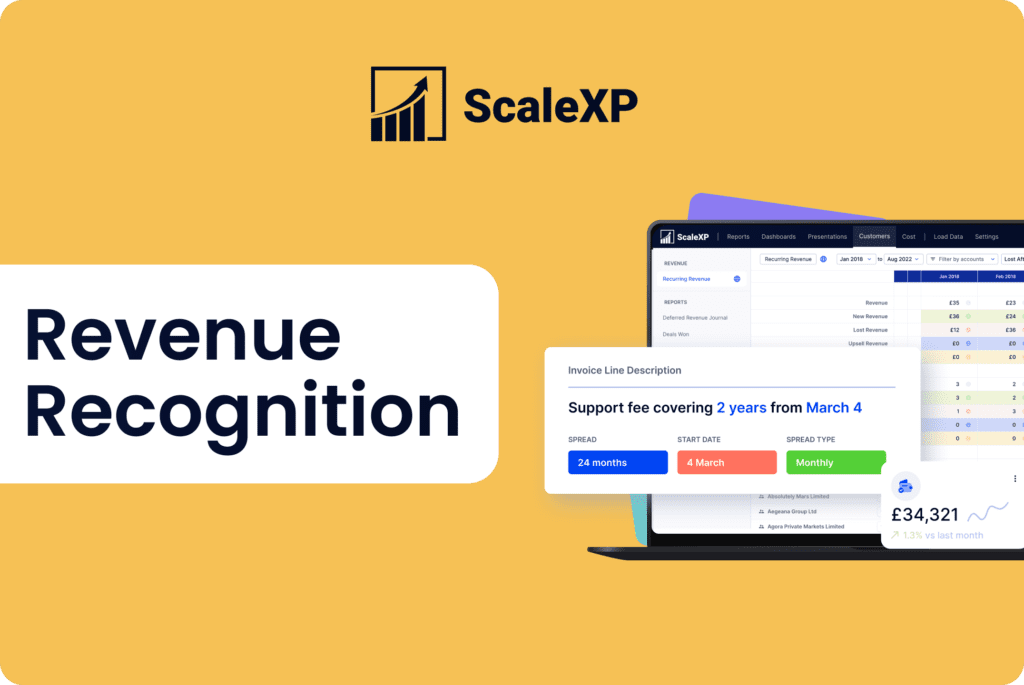There are several methods for revenue recognition. The life of contract method spreads revenue recognition evenly throughout the contract’s duration. Percent completion, often used for projects like construction, recognises revenue as a proportion of the work completed. Finally, the cost recovery method is a conservative approach that delays revenue recognition until all costs related to the sale have been recovered, ensuring payment certainty.
Revenue recognition compliance and standards: IFRS and GAAP
Deciding how and when to record sales in the profit and loss – that is, to recognise revenue – is not always straightforward, particularly for companies which have complicated and drawn out sales transactions. Accounting guidance for recognising revenue is provided by ASC 606 under U.S. GAAP and IFRS 15 under international accounting standards.
The core principle of both ASC 606 and IFRS 15 is that an entity should recognise revenue in a manner that depicts the transfer of promised goods or services to customers in an amount that reflects the consideration to which the entity expects to be entitled in exchange for those goods or servies.
Both ASC 606 and IFRS 15 follow a five-step model to guide revenue recognition as follows:
- Identify the contract(s) with a customer: A contract can be written, verbal, or implied by an entity’s customary business practices. It must be enforceable and specify the payment terms and rights regarding goods or services to be transferred.
Identify the performance obligations in the contract: Performance obligations are promises in a contract to transfer distinct goods or services to the customer. A good or service is distinct if the customer can benefit from it on its own or together with other resources and is separately identifiable from other promises in the contract.
- Determine the transaction price: The transaction price is the amount of consideration an entity expects to be entitled to in exchange for transferring promised goods or services. This includes estimating the amount of variable consideration to which the entity will be entitled.
- Allocate the transaction price to the performance obligations: If a contract contains more than one performance obligation, the transaction price must be allocated to each performance obligation based on the standalone selling prices of the goods or services underlying each performance obligation.
- Recognize revenue when (or as) the entity satisfies a performance obligation: Revenue is recognized when control of the promised good or service is transferred to the customer, either over time (if certain criteria are met) or at a point in time.
1. Life of Contract Method
Overview of life of contract method
The life of contract method recognises income over a contract’s duration.
This method focuses on ensuring the revenue is recognised when (or as) the seller satisfies its performance obligation.
Unlike immediate transaction focused or milestone-specific methods, this approach spreads revenue recognition evenly across the contract’s lifespan, that is, on a straight-line basis.
It’s most appropriate for long-term contracts where services or products are delivered on an ongoing basis.
Example use cases
Industries like construction, software-as-a-service (SaaS), and multi-year maintenance agreements commonly employ the life of contract method of revenue recognition. For example, a SaaS company with upfront payment for a three-year subscription model would recognise the contractual revenue over the subscription’s duration, rather than at the point of invoice or contractual agreement.
Consider a firm signing a five-year agreement to provide cloud storage services. Using the life of contract method, the total contract value is evenly divided over five years, irrespective of the customer’s yearly usage, reflecting the continuous transfer of service to the customer.
Advantages
- Alignment with service delivery, reflecting financial performance over time accurately.
- Smooth revenue stream, providing consistency and predictability.
Disadvantages
- May not be appropriate under GAAP/IFRS standards, for example where performance obligations are clearly not spread evenly across the life of the contract.
- Risk of significantly mis-aligning revenue with related costs and resource allocations, thus misrepresenting both revenue and profitability of the company.
2: Percent Completion Method
Overview of percent completion method
The percent completion method, also known as percentage of completion or percent complete, also recognises revenue when (or as) the seller satisfies its performance obligation but, in this case, the satisfaction of that obligation is not assumed to be spread evenly across the life of the contract.
This method is prevalent in project-based industries such as construction and recognises revenue based on a project’s completion stage. This approach necessitates a reliable progress measure, assessed through agreed milestones, incurred costs, labour hours, or a similar agreed measure of the proportion of total work which has been completed.
Example use cases
The percent complete method suits construction, engineering, and custom manufacturing sectors. For example, a construction company undertaking a multi-year project would record revenue in proportion to the project’s completion each financial period.
A construction company building a bridge determines it’s 40% complete at the fiscal year-end. It recognises 40% of the total contract revenue in its current financial statements accordingly. A common way of estimating percent completion is by measuring costs incurred to date relative to total estimated costs, but other methods can be used as well. Another, related, common way of measuring percent completion is by recording hours used relative to total hours predicted at the start of the project.
Advantages
- Real-time revenue matching, offering an immediate financial view of long-term projects.
- Flexibility in progress measurement through different criteria.
Disadvantages
- Challenges in measuring and agreeing progress.
- Volatile revenue steams (and cost streams for buyer) depending on the amount of progress deemed to have been completed in any given period.
- Potential for fluctuations in total as well as spread over time can lead to complexity in tracking and recording the project revenue.
3: Cost Recovery Method
Overview of cost recovery method
The cost recovery method is a very conservative revenue recognition approach which is used when revenue collection is uncertain.
Revenue is not recognised until all associated costs are recovered, prioritising cost recovery over revenue recognition and ensuring revenue is not recognised until it is virtually certain that it will be realised.
Example use cases
This method is primariy used for scenarios with significant revenue collection uncertainty, this method is seen in high-risk sales industries or with financially unstable customers. A company exporting to a country with volatile economic conditions might adopt this method until payment receipt is assured.
A manufacturer sells machinery to a customer in a high-risk market, incurring £100,000 in costs. It employs the cost recovery method, deferring profit recognition until the full £100,000 is received from the customer. As cash is received, costs are recognised until fully recovered, then sales and profit are recognised. In the meantime, expected revenue is held on the balance sheet as deferred profit.
Advantages
- Mitigates the risk of uncollectible revenue recognition.
- Results in conservative financial statements, beneficial in volatile markets.
Disadvantages
- Delays revenue recognition, affecting reported financial performance and possibly investor perceptions.
- Administrative burden due to meticulous cost tracking for each sale.
Impact on financial reporting
Whether a startup, a growing entity, or a multinational corporation, understanding and implementing revenue recognition principles correctly is fundamental to your financial integrity and compliance.
Your chosen revenue recognition method significantly influences your financial statements, affecting reported sales and profit and many other overall financial health indicators. Selecting a method that best aligns with your operational model and financial reporting needs is crucial for accurately portraying financial performance to stakeholders.
Conclusion
Choosing the appropriate revenue recognition method, of which the most common are life of contract, percent completion, and cost recovery, is crucial for meaningful and compliant financial reporting. Each method presents unique benefits and challenges, with the choice influenced by your business nature, transaction types, and revenue collection certainty. Adherence to IFRS and GAAP standards is essential to ensure your financial reporting accurately mirrors your financial activities, so be sure to contact your local accounting professional for additional advice when making choices for your company’s compliance.
Once you have identified the correct method for your business, save time and improve accuracy by automating your revenue recognition and other reporting with a revenue recognition automation tool like ScaleXP. Book a demo here.








